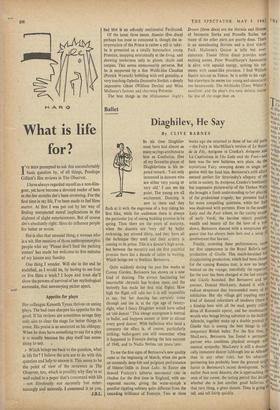Ballet
Diaghilev, He Say
By CLIVE BARNES "ell) ‘‘, Quite suddenly during the past few weeks at Covent Garden, Beriosova has shown us a new kind of dancing. The always fascinating but inscrutable chrysalis has broken open, and the butterfly has made her first trial flights. How high the flight will take her it is still impossible to say, but her dancing has certainly come through and she is, at the ripe age of twenty- eight, what I fancy Diaghilev would have called an 'old dancer.' This abrupt emergence is normal in ballet, and happens sooner or later to almost every good dancer. With ballerinas who head a company the effect is, of course, particularly striking; ballet-goers can still remember when it happened to Fonteyn during the late summer of 1948, and to Nadia Nerina ten years later.
To me the first signs of Beriosova's new quality came at the beginning of March, when she gave an unusually deep-felt and poignant performance of Odcttc/Odile in Swan Lake. At Easter she danced Fonteyn's hitherto sacrosanct role in Ondine for the first time in England, with un- expected success, giving the water-nymph a peculiar rippling subtlety quite different from the cascading brilliance of Fonteyn. Two or three weeks ago she returned to three of her old parts cans, v —the Fairy in MacMillan's version of Le flaisef l° fight de la Fee, Antigone in Cranko's Antigone and farces. La Capricciosa in The Lady and the Fool—and 1(defendhhpc 0 here was the new ballerina writ plain. As the mysterious Fairy sweeping down to single out the Na genius with her fatal kiss, Beriosova's cold allure the slc ih seemed perfect for Stravinsky's allegory of the "'Nog artist in society. In Antigone, Cranko's bombastic I hrce but impressive picture-strip of the Theban Wars, ‘''aS OC she brought a fresh understanding to her playing r)lanY t of the predestined tragedy; her presence had 8 eautiof. far more compelling quietness, while her face satisfac was shadowed with portents. Even in the tawdry Spaii Lady and the Fool where, to the catchy strains Peace of early Verdi, the heroine rejects position. bath or wealth and beauty all for the love of a true of the clown, Beriosova danced with a sumptuous etc' gance that has always been hers and a sense of the rat( involvement that has not. violent Finally, crowning these performances, cattle L'ad b( her first appearance in the Royal Ballet's new production of Giselle. This Much-heralded biJt -nnetit, disappointing production, which had been chosen side, h ,,as or for the coming Russian tour, is now no lone 4 the wanted on the voyage; mercifully the repertorY for the tour has been changed at the last minute. eNtiresc the R" and Giselle banished. But Beriosova and her tleal 01 partner, Donald MacLeary, danced it with 3 time h radiant eloquence that transcended many of its ,t,anguii infelicities. Her shy village girl toppling into 3 'reel( kind of danced coloratura of madness (there 15 ut the a kinship here with all the mad, gently trilling (I sta divas of Romantic opera), and her insubstantial Ihe col wraith who brings loving salvation to the feckless Provid( Albrecht, together make up a double portrait of withou '41(1 th( Giselle that is among the best things in con' 'ension temporary British ballet. For the first time, 16 Nas a MacLeary, Beriosova has found a permanent sides o , partner who combines physical strength witb Fiore i. musical sympathy. MacLeary is still a drarnatv 'auld cally immature dancer (although less as Albrecht lye to than in any other role), but his admiral!'" i Th 4 partnering has probably been the greatest sin6 Anply factor in Beriosova's recent development. NOAlf "lite' earlier than most dancers, she is approaching the', •atises 10 gent crux of her career, the testing period that decideel aril, ' , whether she is just another good ballerina o(j wards Spanisl that rare thing, a great dancer. Time is going tell, and tell fairly quickly.






































 Previous page
Previous page